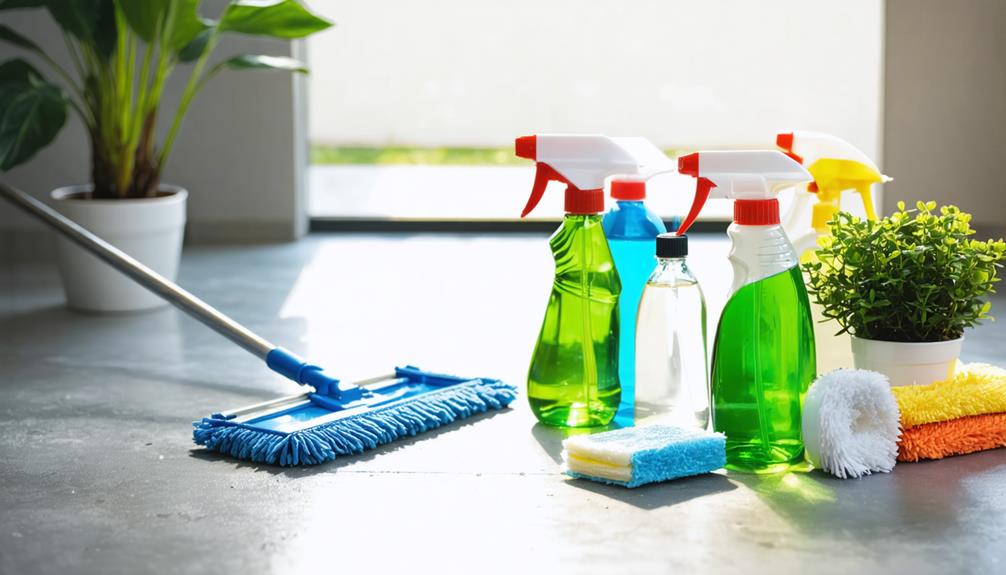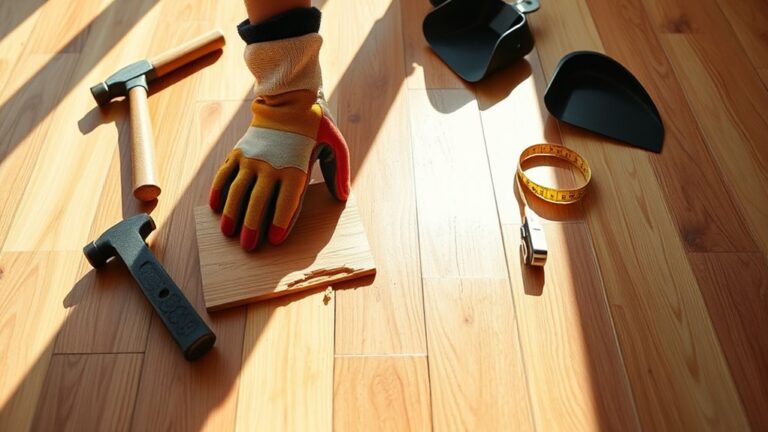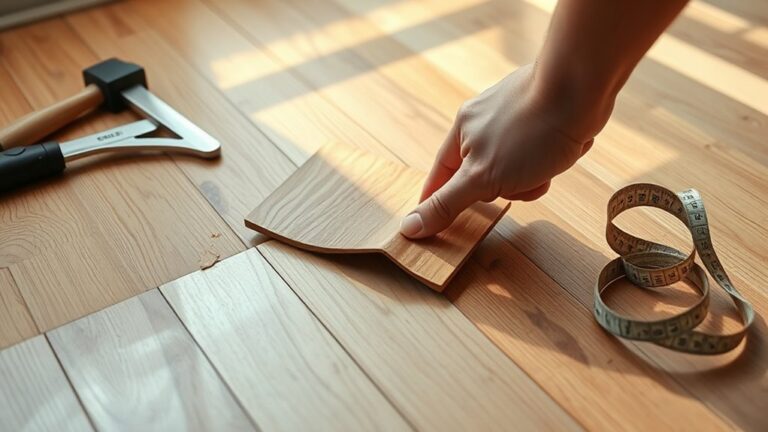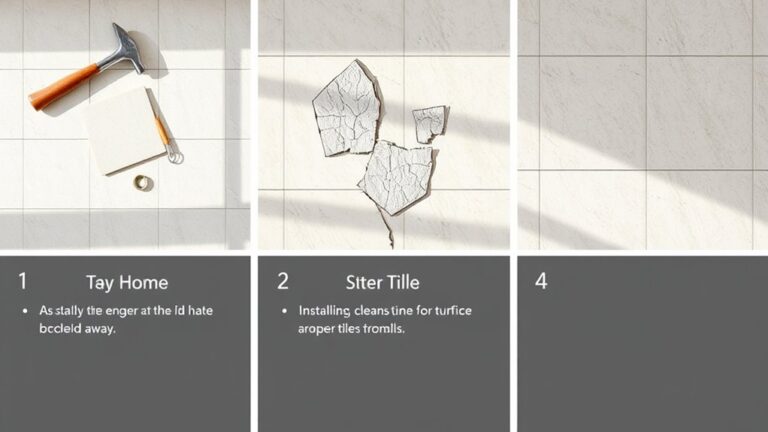To keep your concrete floors looking great, opt for pH-neutral cleaners or a mild dish soap mixed with warm water. These options won't damage sealed surfaces and are perfect for regular maintenance. For tough stains, a baking soda paste works wonders, while a diluted vinegar solution can help with mineral deposits—just use it sparingly. Don't forget essential tools like a soft-bristle scrub brush and microfiber cloths to avoid scratches and streaks. Regular upkeep is key to preserving your floors' beauty and durability. If you're curious about sealing techniques and other maintenance tips, you might find some great insights ahead.
Understanding Concrete Floor Types
When it comes to choosing the right concrete floor type, understanding your options is crucial. Each type serves different aesthetics and functional needs, so let's explore the details.
Polished concrete floors are a popular choice for their smooth, glossy finish. They're ground and polished to perfection, making them low-maintenance and perfect for high-traffic areas. If you're aiming for something more colorful, stained concrete allows you to infuse color into the surface. You can choose between acid-based or water-based stains, creating unique effects that enhance your space's overall look.
For those wanting a natural appearance, stamped concrete mimics materials like stone or brick. This decorative finish is ideal for outdoor spaces, such as patios and driveways. On the other hand, broom-finished concrete offers a practical solution with its non-slip texture, making it a smart choice for sidewalks and driveways.
Exposed aggregate is another stunning option; it reveals decorative stones and aggregates by removing the top layer of cement paste. This technique creates a durable, unique surface that stands out in driveways and patios.
No matter which type you choose, keeping your clean concrete floors looking pristine will require routine maintenance. Use appropriate cleaning solutions and techniques suited for each floor type to guarantee longevity and beauty. With the right knowledge, you can select a concrete floor that meets your needs while also being easy to maintain.
Essential Cleaning Tools
Maintaining the beauty and longevity of your concrete floors relies heavily on the right cleaning tools. To start, a broom or dust mop is essential for removing initial debris. This step is important, as it helps prevent scratching during the cleaning process. Once you've cleared the surface, a wet mop becomes imperative for applying your chosen cleaning solutions effectively. Don't forget a bucket for mixing those solutions; it streamlines the entire cleaning routine.
For finer particles that a broom might miss, a vacuum with a brush attachment is invaluable. It captures dust and prevents it from settling back onto your freshly cleaned floors. Now, if you encounter tough stains, a soft-bristle scrub brush is your best friend. It allows you to scrub gently without damaging the concrete surface, ensuring that your floors remain pristine.
After you've cleaned, drying and buffing are important to avoid streaks. Here's where microfiber cloths come into play. These cloths are perfect for quickly absorbing moisture and providing a streak-free finish. They're soft and effective, making them ideal for your concrete floors.
Recommended Cleaning Solutions
Choosing the right cleaning solutions is essential for preserving the appearance and durability of your concrete floors. pH-neutral cleaners, like Zep Neutral pH Industrial Floor Cleaner, are particularly effective because they maintain the integrity of sealed and polished surfaces without causing damage. If you prefer a more straightforward approach, a mixture of warm water and mild dish soap, such as Dr. Bronner's Pure-Castile Soap, works wonders on sealed concrete while being gentle on the surface.
For those stubborn stains that won't budge, consider using a baking soda paste. Just mix baking soda with water to create a thick paste, apply it to grease stains, and let it sit for a bit before scrubbing gently with a soft brush. If you're dealing with mineral deposits or hard water stains, a diluted vinegar solution can be helpful. However, use it cautiously on sensitive surfaces to avoid etching.
For really tough stains or dirt buildup, specialized commercial cleaners are your best bet. These concrete cleaners are formulated specifically to penetrate deep into the surface without harming the finish, making them excellent for maintaining the beauty of your indoor concrete flooring. By selecting the right cleaning solution, you'll not only keep your floors looking great but also guarantee their longevity and durability.
Step-by-Step Cleaning Process
After selecting the right cleaning solutions for your concrete floors, it's time to implement an effective cleaning process. Start by sweeping or vacuuming the entire surface to remove dust and debris, paying special attention to corners and edges. This initial step is essential for achieving a thorough clean.
Next, mix your cleaning solution. Combine 2 gallons of warm water with 2 teaspoons of a mild cleaner, ensuring it's pH-neutral to protect your concrete floors. With your solution ready, take a damp mop and work in small sections. Remember to rinse the mop frequently to avoid spreading dirt and prevent excess water from pooling on the surface.
If you encounter tough stains, a cleaning expert often recommends creating a paste from baking soda and water. Apply this paste directly to the stain and let it sit for several minutes. Afterward, gently scrub with a soft-bristle brush before rinsing it off.
Once you've mopped and addressed any stains, it's important to dry the floor properly. Use clean microfiber cloths to absorb any remaining moisture, which helps prevent streaks and inhibits mold growth.
Stain Removal Techniques
Concrete floors can be prone to various stains, but there are effective techniques to tackle them. Whether you're dealing with oil, food, rust, or stubborn stains, using the right stain removers and methods can help restore your concrete surface to its former glory. Here are some practical techniques you can use:
- Oil Stains: Sprinkle baking soda or kitty litter over the stain to absorb excess oil. After a while, scrub the area with a soft-bristle brush, then rinse thoroughly with clean water.
- Rust Stains: Create a mixture of lemon juice and vinegar. Apply it to the affected area and let it sit for a few minutes. Rinse well afterward to prevent any further discoloration.
- Food Stains: Combine warm water with dish soap to lift food stains effectively. Apply the solution, scrub gently with a soft-bristle brush, and rinse thoroughly to avoid any soapy residue.
- Stubborn Stains: For particularly tough stains, make a paste using baking soda and water. Apply it directly to the stain, let it sit for several minutes, then scrub gently with a soft-bristle brush before rinsing with clean water.
Sealing and Maintenance Tips
A well-sealed concrete floor is essential to maintaining its durability and aesthetic appeal. To guarantee your floor remains in top condition, apply a quality concrete sealant every two to three years. This proactive step not only prevents stains and damage but also enhances the floor's longevity and overall appearance. When it's time to seal, use a paint roller for an even application on clean, primed surfaces. This guarantees maximum effectiveness and protection against wear.
Regular maintenance is vital. Damp mop your floor with a pH-neutral cleaning solution to maintain the integrity of the sealant over time. This gentle approach helps avoid any degradation that harsh chemicals might cause. Inspections should also be part of your routine; check for cracks or signs of wear regularly. Identifying issues early allows you to make timely repairs, preventing more significant problems down the line.
Lastly, remember that prevention is always easier than correction. Be mindful of what you bring onto your concrete floors—spills can lead to stubborn stains if not addressed promptly. By adopting these sealing and maintenance tips, you'll not only keep your concrete looking great, but you'll also guarantee it stands the test of time. Embrace the freedom that comes with a well-maintained space!
Safety Precautions While Cleaning
When you're tackling the task of cleaning your concrete floors, safety should always be your top priority. To guarantee a safe and effective cleaning process, follow these essential precautions.
- Wear Gloves: Always don gloves to protect your skin from harsh cleaning agents and potential irritants. This small step can save you from discomfort or allergic reactions.
- Use Safety Goggles: Keep safety goggles handy to shield your eyes from splashes, especially when working with strong cleaning solutions. Your eyes are sensitive, and protecting them is vital.
- Guarantee Well-Ventilated Areas: Make sure the area is well-ventilated when using chemicals. This helps prevent inhalation of harmful fumes that can arise from strong cleaning agents, which you should ideally choose with a neutral pH to avoid harsh reactions.
- Choose Non-Slip Footwear: Opt for non-slip footwear while cleaning to minimize the risk of slipping on wet surfaces. This is particularly important as concrete can become quite slippery when wet, posing a significant safety hazard.
Common Mistakes to Avoid
While cleaning your concrete floors, it is crucial to be aware of common mistakes that can lead to damage and increased maintenance costs. One major mistake is using harsh cleaning products, like acidic cleaners, which can etch your concrete surfaces. This damage not only makes your floors more susceptible to stains but can also lead to deterioration over time.
Another pitfall is failing to promptly clean spills. If you let liquids sit, especially on unsealed concrete, they can lead to permanent staining as the porous material absorbs them. Always have a plan to remove dirt and clean spills quickly to maintain your floor's appearance.
Neglecting to use a pH-neutral cleaner is another mistake. These cleaners are specifically designed to protect your floor's sealers and coatings. If you use the wrong product, you may strip away these protective layers, compromising your floor's durability.
Overusing water during cleaning can cause excessive moisture buildup. This moisture can lead to mold growth and weaken the concrete structure, so be mindful of how much water you're using. Finally, avoid abrasive cleaning tools like metal-bristle brushes. These can scratch your floor's finish, necessitating costly repairs or refinishing.
Enhancing Concrete Floor Longevity
To guarantee your concrete floors last for years without costly repairs, implementing a consistent maintenance routine is essential. By following a few straightforward practices, you can enhance the longevity of your floors while keeping them looking pristine.
- Regular Cleaning: Use a pH-neutral cleaner to remove dirt regularly to keep your floors free from buildup. This simple step maintains both the integrity and appearance of your concrete.
- Apply Concrete Sealant: Every two to three years, apply a concrete sealant. This protective layer safeguards against stains and damage, greatly extending the lifespan of your floors and preventing costly repairs.
- Routine Inspections: Regularly inspect your floors for cracks and wear. Catching minor issues early allows for prompt intervention, enhancing durability and preventing small problems from becoming major repairs.
- Use Furniture Pads and Mats: Place furniture pads under heavy items and mats at entry points to minimize scratches and scuffs. These small additions can greatly contribute to the long-term maintenance of your concrete surface.
Avoid using harsh chemicals and abrasive tools during cleaning, as they can damage the sealant and finish. By adhering to these practices, you'll not only enhance the durability of your concrete floors but also enjoy the freedom that comes with a well-maintained space. Embrace these simple steps, and watch your floors thrive for years to come.
Frequently Asked Questions
What Is the Best Thing to Clean Concrete Floors With?
When it comes to cleaning concrete floors, you'll want to hit the nail on the head with eco-friendly options. DIY concrete cleaners and mopping best practices can work wonders. For tough stains, consider stain removal techniques like baking soda paste. Pressure washing benefits can't be overlooked for deeper cleans, while sealing concrete floors provides surface protection. Remember, regular cleaning frequency is key to maintaining that pristine look and ensuring long-lasting durability.
Is Bleach or Vinegar Better for Cleaning Concrete?
When deciding between bleach and vinegar for cleaning concrete, consider bleach's effectiveness for stain removal and odor neutralization. However, it can weaken concrete and cause discoloration. Vinegar offers eco-friendly benefits, being safer for regular cleaning without risking surface etching, especially on sealed areas. Always use safety precautions, like gloves, and test a small area first. For DIY solutions, alternating between both can optimize cleaning frequency while minimizing damage to your concrete surfaces.
What Do Pros Use to Clean Concrete?
You might think cleaning concrete is a chore, but pros have simple tricks up their sleeves. They often rely on power washing for deep cleaning and eco-friendly cleaners for routine maintenance. Heavy-duty degreasers tackle tough stains, while specialized stain removal products handle stubborn marks. Regular cleaning frequency is key, and using concrete sealers helps protect your floors. For DIY solutions, a microfiber mop can work wonders—keeping your space looking fresh without hassle.
Is Pine Sol Good for Cleaning Concrete Floors?
Pine Sol's benefits for cleaning concrete floors are impressive. It's effective for concrete floor maintenance, helping with stain removal when diluted properly. You'll want to rinse afterward to guarantee surface protection. While it's eco-friendly compared to some commercial cleaners, consider DIY cleaning solutions for regular upkeep. For best results, compare products and cleaning frequency based on your needs. Remember, you can always explore alternatives to find what works best for you!




